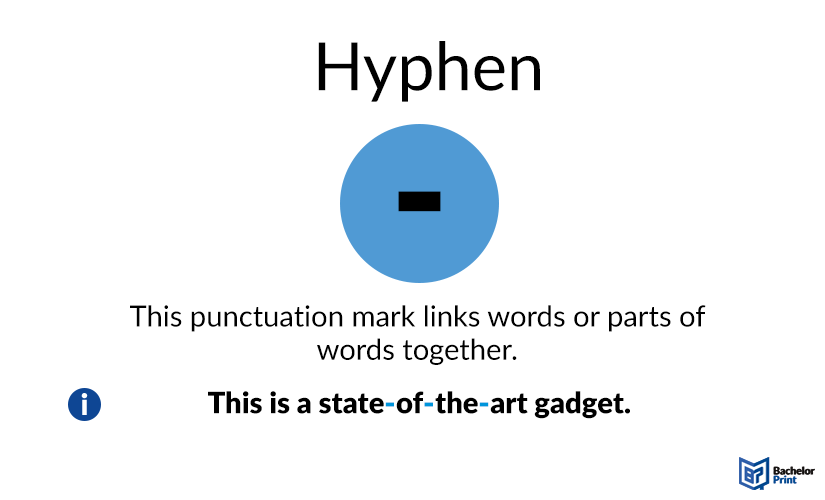
Hyphens (-) are punctuation marks that are utilized to combine two words or to connect parts of a single word by separating its syllables. This practice, known as hyphenation, adheres to specific language rules and is often applied in various contexts, such as when compound modifiers precede the nouns they describe. This article will provide a thorough definition of hyphens, their types, and the correct usage of hyphens in various contexts in academic writing.
Definition: Hyphens
A hyphen (-) is a punctuation mark used to join words or parts of words and to clarify the relationships between them. It serves several key functions, such as, connecting two or more words to shape a single term (compound words) or compound modifiers, which are adjectives consisting of two or more words before a noun.
Hyphens are also used to divide words at the end of a line or, in phonetics and language teaching, to separate syllables in a word, aiding in pronunciation and learning. Additionally, they are used to adding prefixes or suffixes to words to create a new meaning. This can also help in avoiding ambiguity and confusion, like using “re-sign,” meaning “to sign again” vs. “resign,” as in “quitting a job.”

Examples & functions
The table below depicts functions and examples of how to use hyphens.
Types of hyphens
There are distinct types of hyphens, like the non-breaking hyphen, soft hyphen, Unicode hyphen, and double hyphens; the following delves deeper into each type.
Non-breaking hyphen
The non-breaking hyphen, also called the hard hyphen, has the distinct function of preventing two words that are connected by it from being separated at the end of a line. In other words, by using a non-breaking hyphen, compound words will not be split at the end of a line. This ensures that the hyphenated words always appear together on the same line, maintaining the intended meaning and readability. Non-breaking hyphens are commonly found in compound words and modifiers, phone numbers and codes, and names and titles.
While non-breaking hyphens prevent line breaks at the hyphen, non-breaking spaces prevent line breaks at its position. In combination, non-breaking spaces are useful for elements such as numbers, units, dates, and names that contain spaces and hyphens but belong together.
In a typical text editor or word processor, a non-breaking hyphen can be inserted by using specific key combinations or menu options. Below are examples of key combinations for a non-breaking hyphen.
Break hyphen
In contrast to the non-breaking hyphen, the break hyphen has the function of word division. It appears at the end of a line to indicate that a word has been split and continues on the next line. This hyphen is crucial for maintaining the flow and readability of justified text in columns or narrow formats to avoid large gaps by breaking longer words.
Soft hyphen
A soft hyphen, also referred to as a discretionary hyphen or optional hyphen, is a special character used in word-processing and digital typesetting that indicates where a word can be split if it falls at the end of a line. Unlike regular hyphens, discretionary hyphens are invisible unless they cause a line break. In other words, when the word is not split, the soft hyphen can’t be seen; when the word is split, the soft hyphen appears. Optional hyphens are typically relevant in text justification or manual hyphenation.
When used in text justification, the soft hyphen improves the appearance of the text by allowing more flexible line breaks. Furthermore, it is often used by editors and typesetters to manually control hyphenation in a document. In a typical text editor or word processor, you can insert a soft hyphen by using specific key combinations or menu options.
Unicode hyphen
A Unicode hyphen is a particular hyphen character defined by the Unicode standard. The Unicode standard ensures a consistent representation and handling of text across different platforms and systems. The Unicode hyphen is distinct from the common hyphen-minus character found on keyboards to provide accurate control over text formatting and layout. There are several types of Unicode hyphens, each with specific uses and properties. Here are the primary hyphens in Unicode:
This one is the standard keyboard’s most commonly used hyphen. It is generally used in writing and as a minus sign in mathematical contexts.
- Unicode: U+002D
- Symbol: –
The non-breaking hyphen prevents the hyphenated word from being split at the end of a line.
- Unicode: U+2011
- Symbol: ‑
The aforementioned soft hyphen indicates where a word can be split if necessary, and is invisible unless it causes a line break.
- Unicode: U+00AD
- Symbol: -
A dedicated hyphen is used for clearer semantic distinction in typesetting.
- Unicode: U+2010
- Symbol: ‐
The figure dash has a similar width to a digit and is commonly used within numbers.
- Unicode: U+2012
- Symbol: ‒
The en dash is longer than the standard hyphen and is used to imply ranges or connections.
- Unicode: U+2013
- Symbol: –
The em dash is longer than an en dash and is typically used to create a strong break in a sentence.
- Unicode: U+2014
- Symbol: —
Double hyphens
Double hyphens (- -) are typographic elements that can be used in various contexts. However, the usage has evolved over a full stop of time. Traditionally, the double hyphen was used to indicate the em dash before the widespread availability of typographic characters on typewriters and early computers. In modern use, double hyphens are less common due to the dash and diverse hyphen characters.
Hyphens with compound modifiers
Hyphens play an essential role in compound modifiers to ensure correct interpretation. A compound modifier, also called a compound adjective, is a combination of two or more words that adopt the functionality of a single idea within a sentence structure. When two or more words precede a noun to describe it, the first word of the compound is often linked to adjectives by hyphens, avoiding ambiguity. Adverbs are an exception! If the first word of the compound is an adverb, it does not need to be joined to participles or adjectives by hyphens.
If the compound modifier follows the noun, the hyphen is omitted, as the following examples show.
Hyphens with participles
Participles that function as adjectives are often linked with hyphens in compound modifiers to ensure clarity. They help to merge two or more words together, pointing out that they function as a single idea. Compound modifiers can be constructed with the present participle and the past participle.
Hyphens and compound words
As clearly outlined before, hyphens play an essential role in constructing compound words. Compound words are formed when two or more words are combined to create a new word with a specific meaning. The use of hyphens in compound words can vary depending on the types of compound words and the context in which they are used.
Closed compound words
Closed compounds are created by combining two or more words into one single unit without any hyphens or spaces. They represent a specific, unified meaning that often evolves over a full stop of time as the language develops. Closed compounds can consist of nouns, verbs, adjectives, or adverbs.
Open compound words
Open compounds, on the other hand, are two or more separate words that function as a single concept without a hyphen in between but a space. These compounds often consist of adjectives, nouns, or verbs that retain their individual meanings but collectively create a unified idea.
Hyphenated compound words
Hyphenated compounds, are compounded words that are linked together by a hyphen to create a single concept. The hyphenation helps to clarify the relationship between the words and prevents ambiguity. This unambiguous hyphen is used in various parts of speech, including nouns, adjectives, and verbs.
Hyphens and numbers
Using hyphens correctly with numbers enhances clarity and precision in writing. They are integral for connecting compound numbers, indicating ranges, expressing ages, forming compound adjectives with measurements, and formatting phone numbers. There are firm rules for using hyphens with numbers, depending on the respective category.
Hyphens in compound numbers occur from twenty-one to ninety-nine, ordinal numbers, and compound parts of larger numbers.
When fractions function as adjectives and precede nouns, they are commonly hyphenated to ensure clarity. On the other hand, the hyphen is omitted when the fraction acts as an English compound noun.
There are firm rules for hyphenating ages, depending on whether an age functions as an adjective prior to a noun or as a noun itself. Unlike fractions, ages are hyphenated as adjectives and nouns, but are not hyphenated when they come after the noun they modify, or they are part of a prepositional phrase.
Number ranges are properly formatted with hyphens and en dashes without spaces between hyphens and numbers. Hyphens are commonly used in informal contexts, while en dashes are used for formal writing.
Depending on the country and context, the formatting of phone numbers may differ. However, hyphens are commonly used to separate different parts of the phone number, such as the country code, area code, and local number.
Hyphens are used for measurement numbers or units to form compound adjectives. This helps ensure the reader understands that the measurement terms work together to modify the noun. There is no hyphen when the measurement follows the noun.
Hyphens with prefixes
Hyphens are often used to combine words with prefixes to ensure clarity, avoid ambiguity, and enhance readability. Prefixes are words that are added to a base word to create a new meaning. There are several rules that are followed for using hyphens with prefixes.
To avoid confusion, awkward combinations of letters, and ambiguity, hyphens are often used to combine a word and a prefix.
A hyphen is commonly used when the prefix ends in the same letter as the base word begins.
When a prefix is added to a proper noun or adjectives, place a hyphen.
There is a range of prefixes that are followed by a hyphen in combination with other words like “self,” “ex,” “all,” “pre,” “post,” “mid,” and “cross.” Check out the respective examples below.
Hyphens with suffixes
While not as common as hyphens with prefixes, there are specific instances where hyphens with suffixes are necessary. Hyphens with suffixes help to avoid awkward letter combinations, maintain readability, and clearly convey the intended meaning.
Widely used suffixes are “-like” and “-elect.” They are typically always added to another word with a hyphen to create a new meaning.
FAQs
A hyphen (-) is a punctuation mark used to connect words or parts of words. It serves several purposes, such as creating compound words, linking prefixes or suffixes, and indicating word breaks at the end of a line.
Here is a list of examples of using hyphens:
- Mother-in-law
- Well-being
- High-speed
- Well-known
- Re-evaluate
- Ex-president
- Twenty-one
- One-half cup
- Five-year-old child
- Ten-year-old car
- Shell-like
- Buzz-like
There is a variety of ways to connect words and parts of words with hyphens. The most common usages are:
- Compound words
- Compound modifiers
- Prefixes and suffixes
- Numbers
- Fractions
- Ages
Hyphens and dashes are different punctuation marks with distinct purposes:
- Hyphen (-): Short, used for compound words and modifiers.
- En Dash (–): Medium length, used for ranges and connections.
- Em Dash (—): Long, used for parenthetical phrases, interruptions, and appositives.
- ✓ 3D live preview of your individual configuration
- ✓ Free express delivery for every single purchase
- ✓ Top-notch bindings with customised embossing

